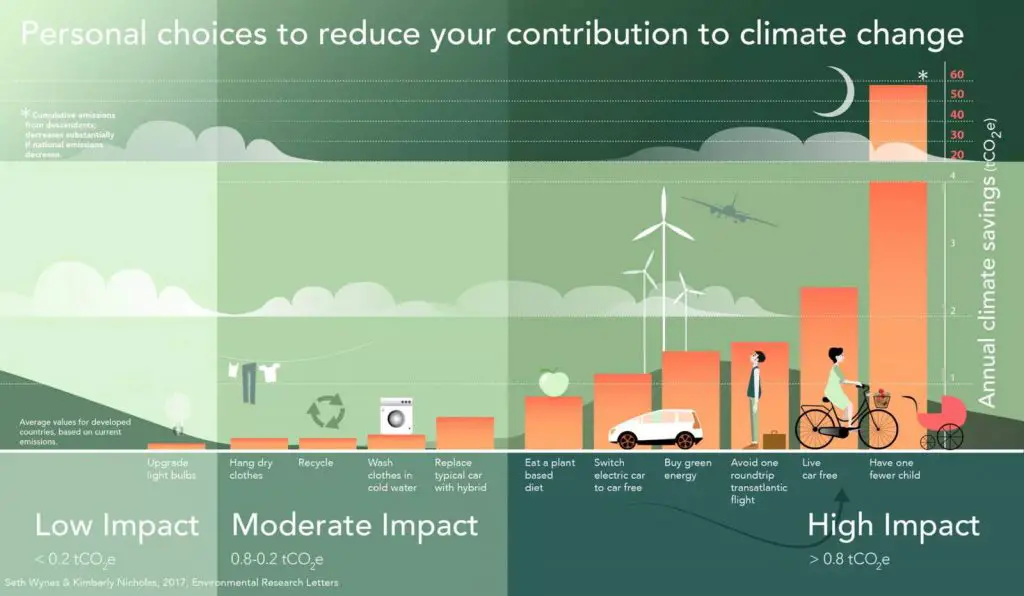Scientists Seth Wynes (University of British Columbia – Vancouver, Department of Geography) and Kimberly A. Nicholas (Lund University, Centre for Sustainability Studies) prepared an infographic that shows how your personal choices affect your contribution to climate change.
Climate change is the biggest threat to humanity and planet Earth, without a doubt. Despite organized and orchestrated climate change science denial, it is real, it is here and we have to act right now.
The evidence for rapid climate change
The evidence for rapid climate change is compelling. According to NASA:
- Global Temperature Rise: The planet’s average surface temperature has risen about 1.62 degrees Fahrenheit (0.9 degrees Celsius) since the late 19th century, a change driven largely by increased carbon dioxide and other human-made emissions into the atmosphere. Most of the warming occurred in the past 35 years, with the six warmest years on record taking place since 2014. Not only was 2016 the warmest year on record, but eight of the 12 months that make up the year – from January through September, with the exception of June – were the warmest on record for those respective months.
- Warming Oceans: The oceans have absorbed much of this increased heat, with the top 700 meters (about 2,300 feet) of ocean showing warming of more than 0.4 degrees Fahrenheit since 1969.
- Shrinking Ice Sheets: The Greenland and Antarctic ice sheets have decreased in mass. Data from NASA’s Gravity Recovery and Climate Experiment show Greenland lost an average of 286 billion tons of ice per year between 1993 and 2016, while Antarctica lost about 127 billion tons of ice per year during the same time period. The rate of Antarctica ice mass loss has tripled in the last decade.
- Glacial Retreat: Glaciers are retreating almost everywhere around the world – including in the Alps, Himalayas, Andes, Rockies, Alaska, and Africa.
- Decreased Snow Cover: Satellite observations reveal that the amount of spring snow cover in the Northern Hemisphere has decreased over the past five decades and that the snow is melting earlier.
- Sea Level Rise: Global sea level rose about 8 inches (20 cm) in the last century. The rate in the last two decades, however, is nearly double that of the last century and is accelerating slightly every year.
- Declining Arctic Sea Ice: Both the extent and thickness of Arctic sea ice have declined rapidly over the last several decades.
- Extreme Events: The number of record high-temperature events in the United States has been increasing, while the number of record low-temperature events has been decreasing, since 1950. The U.S. has also witnessed increasing numbers of intense rainfall events.
- Ocean Acidification: Since the beginning of the Industrial Revolution, the acidity of surface ocean waters has increased by about 30 percent. This increase is the result of humans emitting more carbon dioxide into the atmosphere and hence more being absorbed into the oceans. The amount of carbon dioxide absorbed by the upper layer of the oceans is increasing by about 2 billion tons per year.

Personal choices to reduce your contribution to climate change
But, what can you do, as an individual, to reduce your carbon footprint and contribute to slowing global warming down? Here is how your personal choices affect to reduce your contribution to global warming.

Scientists Seth Wynes and Kimberly A. Nichol divided your personal living choices to reduce your contribution to climate change into three groups – low impact, moderate impact, and high impact. They also gave average values for developed countries based on current emissions.
Low impact (<0.2 tCO2e, see notes 1)
- Upgrading light bulbs
Moderate impact (0.2-0.8 tCO2e)
- Hanging dry clothes
- Recycling
- Washing clothes in cold water
- Replacing a typical car with a hybrid
High impact (>0.8 tCO2e)
- Eating a plant-based diet
- Buying green energy
- Avoiding one trans-Atlantic flight (>1 tCO2e)
- Living car-free (>2 tCO2e)
- Having one fewer child (>50 tCO2e)
Having one fewer child (or no child at all) have the highest impact to reduce your carbon footprint. Its effect is so great that if you have one fewer child, you can travel trans-Atlantic as much as you wish, for example.
Lead author Seth Wynes says:
“There are so many factors that affect the climate impact of personal choices, but bringing all these studies side-by-side gives us the confidence we’ve identified actions that make a big difference. Those of us who want to step forward on climate need to know how our actions can have the greatest possible impact. This research is about helping people make more informed choices.“
“We found there are four actions that could result in substantial decreases in an individual’s carbon footprint: eating a plant-based diet, avoiding air travel, living car-free, and having smaller families. For example, living car-free saves about 2.4 tonnes of CO2 equivalent per year, while eating a plant-based diet saves 0.8 tonnes of CO2 equivalent a year.“
“These actions, therefore, have much greater potential to reduce emissions than commonly promoted strategies like comprehensive recycling (which is 4 times less effective than a plant-based diet) or changing household lightbulbs (8 times less effective).”
Notes
- tCO2e, or Tonnes of CO2e – Tonnes of carbon dioxide equivalent, which is a measure that allows you to compare the emissions of other greenhouse gases relative to one unit of CO2. It is calculated by multiplying the greenhouse gas emissions by its 100-year global warming potential.
Sources
- “The most effective individual steps to tackle climate change aren’t being discussed” by the Institute of Physics on Phys.org
- Climate Change: How Do We Know? on climate.nasa.gov
- tCO2e definition on odlt.org
- Budget of NASA, Year by Year [1980-1989] - June 10, 2024
- Budget of NASA, Year by Year [1970-1979] - June 10, 2024
- Budget of NASA, Year by Year [1958-2024] - June 10, 2024

